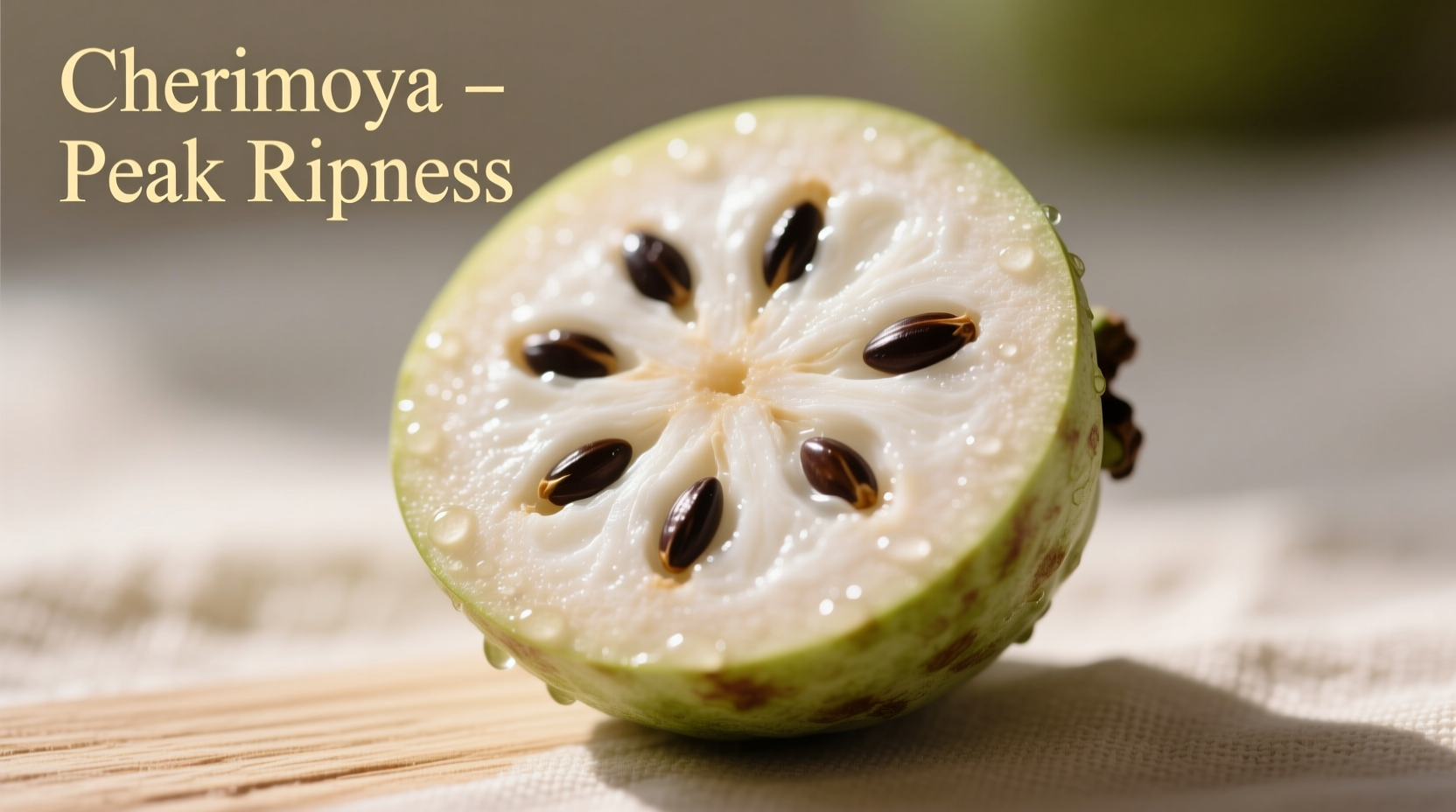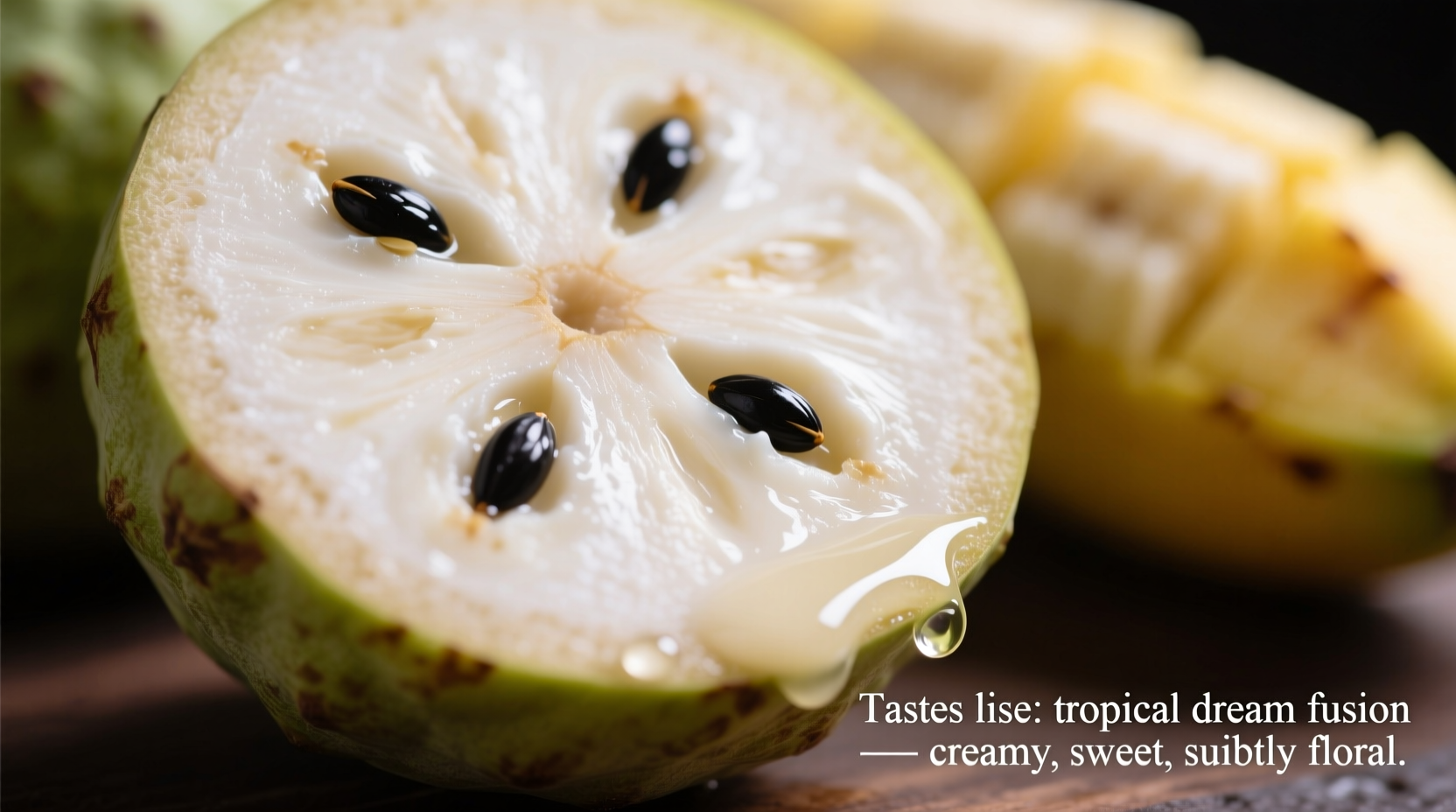The Complete Flavor Profile of Cherimoya
When perfectly ripe, cherimoya delivers one of nature's most complex and delightful flavor experiences. This heart-shaped fruit, scientifically known as Annona cherimola, offers a symphony of flavors that evolve as you eat it. The initial impression is sweet banana with a floral undertone, quickly followed by bright pineapple acidity, then mellowing into strawberry sweetness with citrus zestiness that refreshes the palate.
What truly sets cherimoya apart is its unique texture. Unlike most fruits, it has a creamy, almost custard-like consistency that's why it's often called "custard apple." The flesh is smooth and buttery, containing large black seeds that must be removed before eating. When chilled, the texture becomes even more reminiscent of vanilla ice cream, making it a perfect natural dessert.
How Ripeness Transforms Cherimoya's Flavor
Understanding what does cherimoya taste like depends entirely on ripeness. An unripe cherimoya is astringent and unpleasant, while an overripe one becomes mushy and fermented. The sweet spot delivers the magical flavor combination people rave about.
Here's how to identify perfect ripeness:
- Color: Changes from bright green to slightly yellow-green with possible dark spots
- Texture: Gives slightly when gently pressed (like a ripe avocado)
- Scent: Emits a sweet, fragrant aroma near the stem
- Sound: Ripe cherimoya makes a dull thud when tapped
Unlike many fruits, cherimoya continues ripening after harvest. Place firm fruits at room temperature in a paper bag with an apple to speed ripening through ethylene gas exposure. Once perfectly ripe, refrigerate for up to two days to enjoy at peak flavor.
| Ripeness Stage | Flavor Profile | Texture | Recommended Use |
|---|---|---|---|
| Underripe | Starchy, bland, slightly bitter | Firm, rubbery | Not recommended for eating |
| Perfectly Ripe | Banana-pineapple-strawberry blend | Creamy, smooth custard | Eat fresh, chilled |
| Overripe | Fermented, alcoholic notes | Mushy, stringy | Smoothies, sorbets |
Cherimoya Compared to Other Tropical Fruits
While often compared to other tropical fruits, cherimoya has a distinctive flavor profile that stands apart. Here's how "what does cherimoya taste like" compares to similar fruits:
Banana: Cherimoya shares banana's sweetness but lacks the distinct banana flavor. Instead, it offers more complex layered notes with citrus brightness that banana lacks.
Pawpaw: As North America's native cousin to cherimoya, pawpaw has similar custard texture but more pronounced mango and cantaloupe notes with less citrus complexity.
Sugar Apple (Sweetsop):
Sugar apple shares the same botanical family but has a more granular texture and simpler flavor profile dominated by pineapple notes without cherimoya's strawberry-citrus complexity.
According to research from the University of California's Agricultural and Natural Resources department, cherimoya contains over 40 different volatile compounds that contribute to its complex aroma profile, far more than most common fruits. This chemical complexity explains why many describe cherimoya's taste as "indescribable" yet familiar.
How Temperature Affects Cherimoya Flavor Experience
Temperature significantly impacts what does cherimoya taste like. When served chilled (around 45°F/7°C), the creamy texture becomes more pronounced, enhancing the vanilla-custard notes while mellowing the citrus elements. At room temperature, the fruit reveals more of its bright pineapple and strawberry characteristics.
For the most complete flavor experience, try this technique: refrigerate a perfectly ripe cherimoya for 2-3 hours, then let it sit at room temperature for 15 minutes before eating. This balances the creamy texture with vibrant fruit notes.
Historical Journey of Cherimoya Flavor Appreciation
Cherimoya's unique taste has captivated palates for centuries. Native to the Andean valleys of Peru, Ecuador, and Colombia, this fruit was cultivated by pre-Columbian civilizations who prized its distinctive flavor. Spanish explorers first documented cherimoya in the 16th century, with chronicler Pedro Cieza de León describing it as "the most delicious fruit in the world" in 1553.
The fruit's journey to global appreciation followed this timeline:
- Pre-1500s: Cultivated in Andean valleys by indigenous peoples
- 1526: First European description by Spanish explorers
- 1801: Introduced to Europe by Spanish botanists
- 1871: Brought to California by horticulturist Charles Carman
- 1910s: Commercial cultivation begins in California
- Today: Grown in tropical and subtropical regions worldwide
Despite its long history, cherimoya remains somewhat obscure outside specialty markets, partly because it's delicate and difficult to transport when perfectly ripe. This "best-kept secret" status contributes to the surprise many first-time tasters experience when discovering what does cherimoya taste like.

How to Fully Experience Cherimoya's Flavor
To truly appreciate what does cherimoya taste like, follow these professional tips:
Selection: Choose fruits with slight give when gently squeezed. Avoid those with large brown spots or cracks.
Preparation: Cut the fruit in half lengthwise, then scoop out the flesh with a spoon, avoiding the large black seeds which contain trace amounts of neurotoxic compounds.
Serving: Enjoy chilled for maximum flavor impact. Some enthusiasts recommend a squeeze of lime to enhance the tropical notes, while others prefer it plain to appreciate the natural complexity.
Pairings: Cherimoya complements light wines, coconut milk, and mild spices like cardamom. Try it in smoothies with banana and mango, or simply topped with a sprinkle of cinnamon.
Remember that cherimoya's flavor is highly seasonal, typically available from late fall through early spring in most markets. During peak season (December-February), you'll experience the most vibrant flavor profile.
Why Cherimoya Tastes Different to Different People
Interestingly, what does cherimoya taste like can vary based on individual perception. Research from the Monell Chemical Senses Center shows that genetic variations in taste receptors cause people to experience certain flavor compounds differently. Some tasters detect stronger banana notes, while others perceive more citrus or strawberry elements.
This variation explains why you might find conflicting descriptions of cherimoya's taste online. The fruit's complex chemical composition interacts uniquely with each person's sensory system, creating a personalized flavor experience while maintaining the overall tropical custard profile.











 浙公网安备
33010002000092号
浙公网安备
33010002000092号 浙B2-20120091-4
浙B2-20120091-4